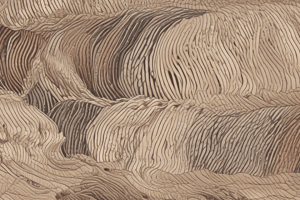Podcast
Questions and Answers
Silk is made by silkworm caterpillars feeding on ______ leaves.
Silk is made by silkworm caterpillars feeding on ______ leaves.
mulberry
Silk was first produced around 2700 BC in ancient ______.
Silk was first produced around 2700 BC in ancient ______.
China
Wool comes from sheep ______.
Wool comes from sheep ______.
hair
After being shorn, wool needs to go through several steps before becoming usable ______.
After being shorn, wool needs to go through several steps before becoming usable ______.
Synthetic materials like viscose rayon, ______, or polyester are commonly used in textiles.
Synthetic materials like viscose rayon, ______, or polyester are commonly used in textiles.
Viscose rayon involves combining cellulose pulp derived from wood with other ingredients, such as sodium hydroxide and carbon disulfide. This results in long chains of molecules forming networks capable of absorbing dyes easily due to its ______.
Viscose rayon involves combining cellulose pulp derived from wood with other ingredients, such as sodium hydroxide and carbon disulfide. This results in long chains of molecules forming networks capable of absorbing dyes easily due to its ______.
Nylons are synthetic polymers containing amino groups bonded together tightly providing strength while keeping lightweight properties. Nylons have numerous applications ranging from clothing items worn daily to ______-use products.
Nylons are synthetic polymers containing amino groups bonded together tightly providing strength while keeping lightweight properties. Nylons have numerous applications ranging from clothing items worn daily to ______-use products.
Polyester creates artificial fiber mainly composed out of manmade monomers synthesized chemically instead coming naturally like most organic compounds do. Polyester fibers typically look similar yet possess distinct characteristics compared against traditional counterparts making them suitable ______ options.
Polyester creates artificial fiber mainly composed out of manmade monomers synthesized chemically instead coming naturally like most organic compounds do. Polyester fibers typically look similar yet possess distinct characteristics compared against traditional counterparts making them suitable ______ options.
Viscose rayon and nylon may require special processing conditions during manufacturing stages unlike ______ fibers found earlier herein.
Viscose rayon and nylon may require special processing conditions during manufacturing stages unlike ______ fibers found earlier herein.
Polyester offers durability combined with economical pricing, making it a popular choice among consumers everywhere ______.
Polyester offers durability combined with economical pricing, making it a popular choice among consumers everywhere ______.
Flashcards are hidden until you start studying
Study Notes
Textiles refer to any type of cloth or fabric woven together from fibers such as cotton, silk, wool, or synthetic materials like viscose rayon, nylon, or polyester. Fabric is defined simply as 'woven material,' which can also involve knitting or weaving various yarns into different patterns. Here's a closer look at some common textile fibers used throughout history:
Silk
Silk is one of the oldest known fibers, made by silkworm caterpillars feeding on mulberry leaves. It was first produced around 2700 BC in ancient China when farmers noticed how much food these tiny creatures ate! Since then it has been highly prized because it feels luxurious under your fingers—like velvet without the stiffness. In terms of production, raw silk fibers must be unwound from cocoons before they can be spun into thread; this delicate process preserves their unique, luminous quality.
Wool
Wool comes from sheep hair, which grows continuously until shearing time each spring. After being shorn, wool needs to go through several steps before becoming usable fabric. Firstly, sheep are washed with warm water mixed with soap chemicals called detergents. Then their wool goes through carding where all the tangled bits get pulled apart using metal teeth attached onto rotating drums. Finally there’s combing stage where individual strands are gathered up by combs running over them gently. When finished, you end up having fleece ready for spinning threads – that will form soft coverings later on.
Viscose Rayon & Nylon
Viscose rayon involves combining cellulose pulp derived from wood with other ingredients, such as sodium hydroxide and carbon disulfide. This results in long chains of molecules forming networks capable of absorbing dyes easily due to its structure. As for Nylons – synthetic polymers containing amino groups bonded together tightly providing strength while keeping lightweight properties. Both types have numerous applications ranging from clothing items worn daily to industrial-use products; however both may require special processing conditions during manufacturing stages unlike natural fibres found earlier herein.
Polyester
Polyester creates artificial fiber mainly composed out of manmade monomers synthesized chemically instead coming naturally like most organic compounds do. These fibers typically look similar yet possess distinct characteristics compared against traditional counterparts making them suitable substitute options depending upon specific requirements given purpose wise. This versatile material offers durability combined economical pricing making popular choice among consumers everywhere today.
Studying That Suits You
Use AI to generate personalized quizzes and flashcards to suit your learning preferences.




